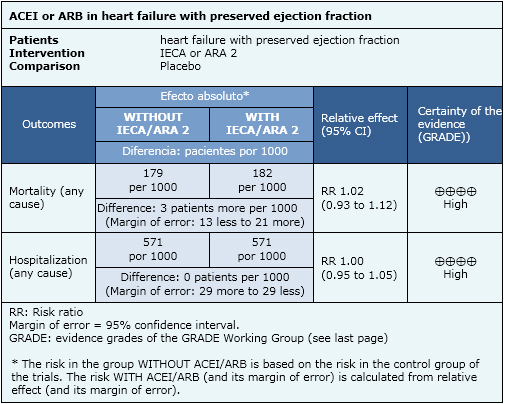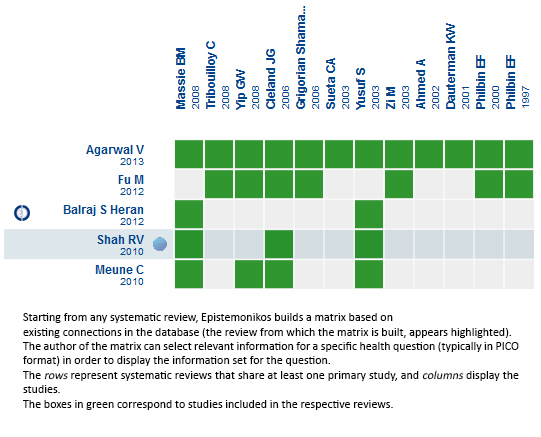Epistemonikos summaries
← vista completaPublished on March 20, 2015 | http://doi.org/10.5867/medwave.2015.02.6101
Are angiotensin-converting enzyme inhibitors or angiotensin 2 receptor antagonists effective in heart failure with preserved ejection fraction?
¿Son efectivos los inhibidores de enzima convertidora o los antagonistas del receptor de angiotensina 2 en pacientes con insuficiencia cardiaca y fracción de eyección conservada?
Abstract
Angiotensin-converting enzyme inhibitors (ACEI) and angiotensin receptor blockers (ARB) constitute first line treatment for patients with heart failure with reduced ejection fraction. However, their role in patients with preserved ejection fraction remains controversial. Searching in Epistemonikos database, which is maintained by screening 30 databases, we identified five systematic reviews including five randomized trials. We combined the evidence using meta-analysis and generated a summary of findings table following the GRADE approach. We concluded ACEI and ARB do not decrease mortality or hospitalization risk in this group of patients.
Problem
Angiotensin-converting enzyme inhibitors and angiotensin receptor blockers slow progression of disease and mortality in patients with heart failure and low ejection fraction. The effect on cardiac remodeling is considered the main mechanism of action, and it is also present in patients with preserved ejection fraction, so this benefit might extend to this group too.
Methods
We used Epistemonikos database, which is maintained by screening more than 30 databases, to identify systematic reviews and their included primary studies.
With this information we generated a structured summary using a pre-established format, which includes key messages, a summary of the body of evidence (presented as an evidence matrix in Epistemonikos), meta-analysis of the total of studies, a summary of findings table following the GRADE approach and a table of other considerations for decision-making.
|
Key Messages
|
About the body of evidence for this question
|
What is the evidence. See evidence matrix in Epistemonikos later |
|
|
What types of patients were included |
All studies considered heart failure of any etiology. Ejection fraction was >40% in three studies [6],[15],[16] and > 45% in two [9],[14]. |
|
What types of interventions were included |
All studies compared against placebo or standard treatment, which generally included diuretics. |
|
What types of outcomes were measured |
|
Summary of findings
The information on the effects of ACEI or ARB is based on five randomized trials [6],[9],[14],[15],[16] including 8226 patients. All studies reported total mortality and only three reported hospitalization by any cause [9],[15],[16].
- Angiotensin-converting enzyme inhibitors and angiotensin receptor blockers do not decrease mortality or hospitalization risk in patients with heart failure and preserved ejection fraction. The certainty of the evidence is high.

Renin-angiotensin system blockade in heart failure with preserved ejection fraction
Other considerations for decision-making
|
To whom this evidence does and does not apply |
|
| About the outcomes included in this summary |
|
| Balance between benefits and risks, and certainty of the evidence |
|
| Resource considerations |
|
|
Differences between this summary and other sources |
| Could this evidence change in the future? |
|
How we conducted this summary
Using automated and collaborative means, we compiled all the relevant evidence for the question of interest and we present it as a matrix of evidence.
 Full size
Full size Follow the link to access the interactive version Renin-angiotensin system blockade in heart failure with preserved ejection fraction

Notes
The upper portion of the matrix of evidence will display a warning of “new evidence” if new systematic reviews are published after the publication of this summary.
Even though the project considers the periodical update of these summaries, users are invited to comment in the website of Medwave or to contact the authors through email if they realize there is new evidence and the summary should be updated earlier.
After creating an account in Epistemonikos, users will be able to save the matrixes and to receive automated notifications any time new evidence potentially relevant for the question appears.
The details about the methods used to produce this summaries are described here http://dx.doi.org/10.5867/medwave.2014.06.5997.
Epistemonikos foundation is a non-for-profit organisation aiming to bring information closer to those making health decisions, through the use of technology. Its main development is Epistemonikos database (www.epistemonikos.org).
These summaries follow a rigorous process of internal peer review.

